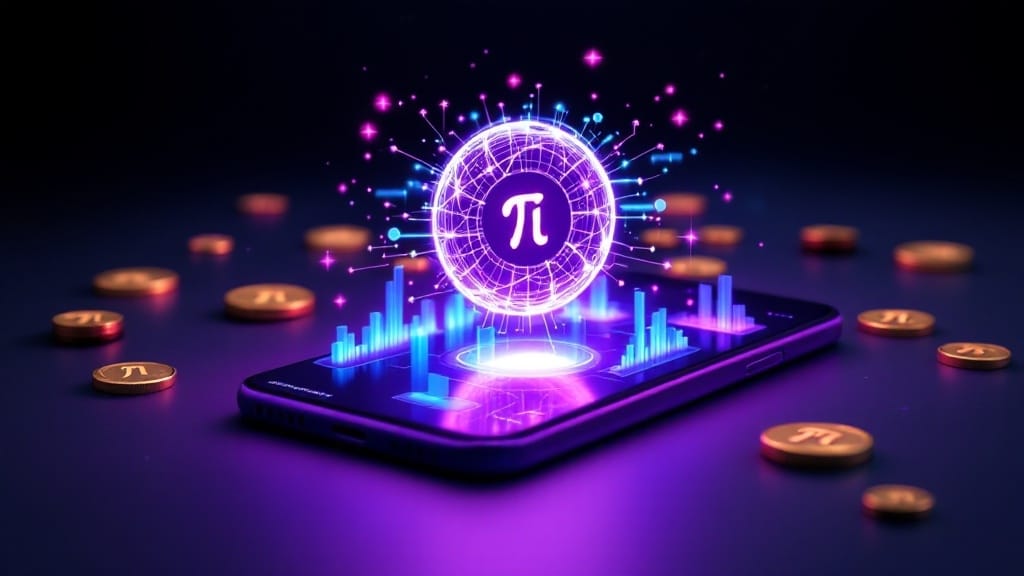Pi Network’s upcoming shift to public trading on February 20, 2025, positions the cryptocurrency for significant market exposure, with initial trading values projected at $1.90. The platform, boasting over 50 million users, integrates eco-friendly mining practices with an all-encompassing Web3 infrastructure, including Pi Chats and smart contract functionality. Market analysts present optimistic scenarios, suggesting potential values reaching $196 by end-2025, while the platform’s unique consensus mechanism and multi-role participation structure lay groundwork for broader market impact.

As Pi Network shifts from its Enclosed Mainnet phase to public trading as of February 20, 2025, the cryptocurrency project has garnered significant attention from both retail and institutional investors. The platform, boasting over 50 million users, has successfully launched its native Pi Coin with an initial trading value of approximately $1.90, encountering resistance levels above $2 while maintaining support zones at $1.64 and $1.51. Created by Stanford graduates, the network has established itself as a pioneering force in mobile-based cryptocurrency mining and development. The network’s commitment to eco-friendly mining sets it apart from energy-intensive cryptocurrencies in the market.
The ecosystem has evolved to incorporate multiple features designed to improve user engagement and functionality, including Pi Chats, Fireside Forum, and the Brainstorm app, collectively forming a thorough Web3 infrastructure. These components operate within a framework where users can participate as Pioneers, Contributors, Ambassadors, or Nodes, each role contributing distinctively to network stability and growth. Some investors are exploring self-directed IRAs to include Pi Network in their retirement portfolios, though this requires careful consideration of associated fees and regulatory requirements.
Pi Network’s multi-role ecosystem empowers users through specialized functions, fostering collaborative growth while maintaining decentralized network integrity.
Market analysts have projected differing price trajectories for Pi Coin, with optimistic scenarios suggesting potential values reaching up to $196 by the end of 2025. These predictions, while speculative, are influenced by several key factors, including anticipated listings on major cryptocurrency exchanges like Binance, general market sentiment, and the broader adoption of Pi Network’s payment solutions.
The shift to public trading represents a vital milestone for Pi Network, which aims to establish itself as the most inclusive peer-to-peer marketplace while enabling smart contract functionality. The platform’s innovative consensus mechanism, implemented through its mobile application, continues to promote financial inclusion and accessibility, distinguishing it from traditional cryptocurrency mining approaches.
Current market indicators suggest a potential bullish reversal, supported by increased buy orders and growing investor confidence. However, future valuations remain contingent on differing factors, including regulatory developments, global cryptocurrency market conditions, and the success of planned business integrations.
The platform’s ability to maintain its development momentum while fostering real-world adoption will likely play a decisive role in determining its long-term market position and value proposition within the broader cryptocurrency ecosystem.
FAQs
How Secure Is Pi Network’s Blockchain Technology Compared to Other Cryptocurrencies?
Pi Network’s blockchain employs robust security through multiple mechanisms, including Byzantine Fault Tolerance and a decentralized web of trust.
The network’s node-based architecture, combined with identity verification protocols and security circles, provides protection comparable to established cryptocurrencies.
However, concerns about data privacy and past security incidents suggest potential vulnerabilities, while the energy-efficient consensus mechanism maintains reliability without compromising security standards.
Can Pi Network Be Mined Without Draining My Phone’s Battery Life?
Pi Network’s mining process is specifically engineered for minimal battery consumption through its Stellar Consensus Protocol.
The system’s AI-driven algorithms automatically adjust mining parameters to prevent excessive power drain, while maintaining network security.
Unlike traditional cryptocurrency mining, Pi’s mobile-first approach eliminates intensive computational requirements, allowing users to mine continuously without significant impact on battery life or device performance.
What Businesses Currently Accept Pi Coins as Payment?
Several businesses across Asia and the United States have integrated Pi Coin payments into their operations.
In Asia, BYD Auto Service Co. accepts full Pi payments for vehicles, while Queanh Gia Coffee in Vietnam processes Pi transactions.
In the United States, Florida-based companies like Zito Realty and Cube Motor accept Pi Coin for property and vehicle purchases, respectively.
Multiple retail establishments, particularly in South Korea, also accommodate Pi Coin transactions.
How Does Pi Network Verify User Authenticity During the KYC Process?
Pi Network verifies user authenticity through a multi-layered KYC process that combines automated and human verification systems.
Users must submit government-issued identification documents through the Pi Browser app, complete a facial liveness check for biometric verification, and undergo document validation.
The system employs machine learning algorithms to cross-reference submitted data, while human validators review cases for additional verification, ensuring compliance with global identity standards.
Will Pi Network Be Available to Mine After Mainnet Launch?
Mining activities will continue after the mainnet launch, though with modified reward structures following an exponential decline model.
The shift to open mainnet preserves mining functionality while introducing new ecosystem features and applications.
Users must complete KYC verification and mainnet migration to participate in post-launch mining, with rewards potentially decreasing over time due to network maturation and increased user participation.









